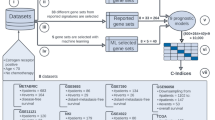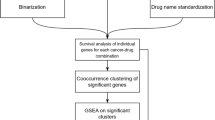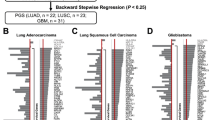Abstract
We used cDNA microarrays to assess gene expression profiles in 60 human cancer cell lines used in a drug discovery screen by the National Cancer Institute. Using these data, we linked bioinformatics and chemoinformatics by correlating gene expression and drug activity patterns in the NCI60 lines. Clustering the cell lines on the basis of gene expression yielded relationships very different from those obtained by clustering the cell lines on the basis of their response to drugs. Gene-drug relationships for the clinical agents 5-fluorouracil and L-asparaginase exemplify how variations in the transcript levels of particular genes relate to mechanisms of drug sensitivity and resistance. This is the first study to integrate large databases on gene expression and molecular pharmacology.
This is a preview of subscription content, access via your institution
Access options
Subscribe to this journal
Receive 12 print issues and online access
$209.00 per year
only $17.42 per issue
Buy this article
- Purchase on SpringerLink
- Instant access to full article PDF
Prices may be subject to local taxes which are calculated during checkout





Similar content being viewed by others
References
Boyd, M.R. & Paull, K.D. Some practical considerations and applications of the National Cancer Institute in vitro anticancer drug discovery screen. Drug Dev. Res. 34, 91– 109 (1995).
Alley, M.C. et al. Feasibility of drug screening with panels of human tumor cell lines using a microculture tetrazolium assay. Cancer Res. 48, 589–601 (1988).
Monks, A. et al. Feasibility of a high flux anticancer drug screen using a diverse panel of cultured human tumor cell lines. J. Natl Cancer Inst. 83, 757–766 (1991).
Grever, M.R., Schepartz, S.A. & Chabner, B.A. The National Cancer Institute: cancer drug discovery and development program. Semin. Oncol. 19, 622–638 (1992).
Stinson, S.F. et al. Morphological and immunocytochemical characteristics of human tumor cell lines for use in a disease-oriented anticancer drug screen. Anticancer Res. 12, 1035–1053 (1992).
Boyd, M.R. in Anticancer Drug Development Guide: Preclinical Screening, Clinical Trials, and Approval (ed. Teicher, B.A.) 23–42 (Humana Press, Totowa, 1997).
Ross, D.T. et al. Systematic variation in gene expression patterns in human cancer cell lines. Nature Genet. 24, 227– 235 (2000).
Weinstein, J.N. et al. An information-intensive approach to the molecular pharmacology of cancer. Science 275, 343– 349 (1997).
Weinstein, J.N. et al. Neural computing in cancer drug development: predicting mechanism of action. Science 258, 447– 451 (1992).
van Osdol, W.W., Myers, T.G., Paull, K.D., Kohn, K.W. & Weinstein, J.N. Use of the Kohonen self-organizing map to study the mechanisms of action of chemotherapeutic agents. J. Natl Cancer Inst. 86, 1853–1859 ( 1994).
Paull, K.D., Hamel, E. & Malspeis, L. Prediction of biochemical mechanism of action from the in vitro antitumor screen of the National Cancer Institute. in Cancer Chemotherapeutic Agents (ed. Foye, W.E.) 1574– 1581 (American Chemical Soc. Books, Washington, DC, 1993).
Paull, K.D. et al. Display and analysis of patterns of differential activity of drugs against human tumor cell lines: development of mean graph and COMPARE algorithm. J. Natl Cancer Inst. 81, 1088 –1092 (1989).
Shi, L.M., Fan, Y., Myers, T.G., Paull, K.D. & Weinstein, J.N. Mining the NCI anticancer drug discovery databases: genetic function approximation for the quantitative structure-activity relationship study of anticancer ellipticine analogs. J. Chem. Inf. Comput. Sci. 38, 189–199 ( 1998).
Shi, L.M. et al. Mining the National Cancer Institute's anticancer drug screen database: cluster analysis of ellipticine analogs with p53-inverse and central nervous system-selective patterns of activity. Mol. Pharmacol. 53, 241–251 (1998).
Alvarez, M. et al. Generation of a drug resistance profile by quantitation of MDR-1/P-glycoprotein expression in the cell lines of the NCI anticancer drug screen. J. Clin. Invest. 95, 2205– 2214 (1995).
Izquierdo, M.A. et al. Overlapping phenotypes of multidrug resistance among panels of human cancer-cell lines. Int. J. Cancer 65, 230–237 (1996).
O'Connor, P.M. et al. Characterization of the p53-tumor suppressor pathway in cells of the National Cancer Institute anticancer drug screen and correlations with the growth-inhibitory potency of 123 anticancer agents. Cancer Res. 57, 4285–4300 ( 1997).
Freije, J.M. et al. Identification of compounds with preferential inhibitory activity against low-Nm23-expressing human breast carcinoma and melanoma cell lines . Nature Med. 3, 395–401 (1997).
Koo, H.-M. et al. Enhanced sensitivity to 1-β-D-arabinofuranosylcytosine and topoisomerase II inhibitors in tumor cell lines harboring activated ras oncogenes. J. Natl Cancer Inst. 56, 5211 –5216 (1996).
Wosikowski, K. et al. Identification of epidermal growth factor receptor and c-erbB2 pathway inhibitors by correlation with gene expression patterns. J. Natl Cancer Inst. 89, 1505–1513 (1997).
Bates, S.E. et al. Reversal of multidrug resistance. Prog. Clin. Biol. Res. 389, 33–37 ( 1994).
Bates, S.E. et al. Molecular targets in the National Cancer Institute drug screen . J. Cancer Res. Clin. Oncol. 121, 495– 500 (1995).
Lee, J.-S. et al. Rhodamine efflux patterns predict P-glycoprotein substrates in the National Cancer Institute drug screen. Mol. Pharmacol. 46, 627–638 (1994).
Wu, L. et al. Multidrug-resistant phenotype of disease-oriented panels of human tumor cell lines used for anticancer drug screening. Cancer Res . 52, 3029–3034 ( 1992).
Kitada, S. et al. Expression and location of pro-apoptotic Bcl-2 family protein BAD in normal human tissues and tumor cell lines. Am. J. Pathol . 152, 51–61 ( 1998).
Monks, A., Scudiero, D.A., Johnson, G.S., Paull, K.D. & Sausville, E.A. The NCI anti-cancer drug screen: a smart screen to identify effectors of novel targets. Anticancer Drug Des. 12, 533–541 ( 1997).
Weinstein, J.N. Fishing expeditions. Science 282, 627 (1998).
Myers, T.G. et al. A protein expression database for the molecular pharmacology of cancer. Electrophoresis 18, 647– 653 (1997).
Schena, M., Shalon, D., Davis, R.W. & Brown, P.O. Quantitative monitoring of gene expression patterns with a complementary DNA microarray. Science 270, 467–470 ( 1995).
Schena, M. et al. Parallel human genome analysis: Microarray-based expression monitoring of 1000 genes. Proc. Natl Acad. Sci. USA 93, 10614–10619 (1996).
DeRisi, J. et al. Use of a cDNA microarray to analyse gene expression patterns in human cancer. Nature Genet. 14, 457– 460 (1996).
Scudiero, D.A., Monks, A. & Sausville, E.A. Cell line designation change: multidrug-resistant cell line in the NCI anticancer screen. J. Natl Cancer Inst. 90, 862 (1998).
Capranico, G. et al. Mapping drug interactions at the covalent topoisomerase II-DNA complex by bisantrene/amsacrine congeners. J. Biol. Chem. 273, 12732–12739 (1998).
Chen, A.Y. & Liu, L.F. DNA topoisomerases: essential enzymes and lethal targets. Annu. Rev. Pharmacol. Toxicol. 94, 194–218 (1994).
Pommier, Y., Tanizawa, A. & Kohn, K.W. Mechanism of topoisomerase I inhibition by anticancer drugs. Adv. Pharmacol. 29B, 73– 92 (1993).
Shao, R.-G. et al. Replication-mediated DNA damage by camptothecin induces phosphorylation of RPA by DNA-dependent protein kinase and dissociates RPA:DNA-PK complexes . EMBO J. (in press).
Pommier, Y. DNA topoisomease II inhibitors. in Cancer Therapeutics: Experimental and Clinical Agents (ed. Teicher, B.A.) 153–174 (Humana Press, Totowa, 1997).
Weinstein, J.N. et al. Predictive statistics and artificial intelligence in the U.S. National Cancer Institute's drug discovery program for cancer and AIDS. Stem Cells 12, 13–22 ( 1994).
Eisen, M.B., Spellman, P.T., Brown, P.O. & Botstein, D. Cluster analysis and display of genome-wide expression patterns. Proc. Natl Acad. Sci. USA 95, 14863– 14868 (1998).
Fischel, J.L. et al. Dihydropyrimidine dehydrogenase: a tumoral target for fluorouracil modulation. Clin. Cancer Res. 1, 991– 996 (1995).
McLeod, H.L. et al. Characterization of dihydropyrimidine dehydrogenase in human colorectal tumours. Br. J. Cancer 77, 461 –465 (1998).
Cooney, D.A. & Handschumacher, R.E. L-asparaginase and L-asparagine metabolism. Annu. Rev. Pharmacol. 10, 421 –440 (1970).
Capizzi, R.L., Bertino, J.R. & Handschumacher, R.E. L-Asparaginase. Annu. Rev. Med. 21, 433–444 (1970).
Efron, B. & Gong, G. A leisurely look at the bootstrap, the jackknife, and cross-validation. Am. Statistician 37, 36–48 (1983).
Wada, H. et al. Antitumor enzyme: polyethylene glycol-modified asparaginase. Ann. NY Acad. Sci. 613, 95–108 (1990).
Tanabe, L. et al. MedMiner: an internet tool for mining the biomedical literature, with application to gene expression profiling. Biotechniques 27, 1210–1217 (1999).
Brown, P.O. & Botstein, D. Exploring the new world of the genome with DNA microarrays. Nature Genet. 21 (suppl.), 33–37 (1999 ).
Shalon, D., Smith, S.J. & Brown, P.O. A DNA microarray system for analyzing complex DNA samples using two-color fluorescent probe hybridization. Genome Res. 6, 639–645 ( 1996).
Acknowledgements
We thank the staff of the NCI DTP, particularly K.D. Paull, whose efforts over the years have resulted in the pharmacological databases used in this study. This study was supported in part by NCI grant CA77097 and by the Howard Hughes Medical Institute. D.T.R. is a Walter and Iden Berry Fellow. P.O.B. is an associate investigator of the Howard Hughes Medical Institute. The work of U.S. and J.N.W. was supported in part by a grant from the NCI intramural Breast Cancer Think Tank.
Author information
Authors and Affiliations
Corresponding authors
Rights and permissions
About this article
Cite this article
Scherf, U., Ross, D., Waltham, M. et al. A gene expression database for the molecular pharmacology of cancer. Nat Genet 24, 236–244 (2000). https://doi.org/10.1038/73439
Received:
Accepted:
Issue Date:
DOI: https://doi.org/10.1038/73439



